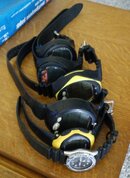Hello All,
Recently I purchased a new dive computer. On the first few dives I compared it with some of my old computors for sensor accuracy and NDL.
New Computer: Oceanic Veo 2.0 set to the DSAT algorith, air and no conservatism factor.
Previous Computer: Cressi Archimede set to air and no conservatism factor. This is my trusted reference computer. I have several hundred dives on this computer with no decompression problems.
Third Computer: Suunto Mosquito set to 24% nitrox and no conservatism factor. I knew from previous experience that this Suunto is super conservative. I set it to 24% nitrox to try to make it at least usable with the other computers.
On the first day, I carried the new Oceanic and the Cressi. At the end of the second dive the Cressi showed less than 3 minutes NDL and the Oceanic something like 15 minutes. I obeyed the Cressi without entering deco.
On the second day, I carried the Oceanic, the Cressi and added the Suunto. At the end of the second dive the Suunto showed 11 minutes of deco obligation. The Cressi showed 6 minutes of deco obligation and the Oceanic was still happily showing about 15 minutes of NDL. I did the extra hang to clear the Cressi and disregarded the Suunto as usual.
For the rest of the long vacation I dived nearly every day and carried only the Oceanic and obeyed the limits of that computer. I suffered no ill health effects.
Conclusions: There is a wide variation in NDL provided by different dive computer models. I really enjoyed the extra limits provided by a less conservative computer.
Final notes: When switching dive computers, I think it is good practice to compare the new computer with your old computer. In this way you can get a feel for the differences in conservatism. If the new computer is less conservative you can consider dialing in a conservatism factor. In my case, I decided to enjoy the extra bottom times offered by my new computer. Diving conditions were very mild and I have no health problems. Please don't call the PADI police.
Pete

Recently I purchased a new dive computer. On the first few dives I compared it with some of my old computors for sensor accuracy and NDL.
New Computer: Oceanic Veo 2.0 set to the DSAT algorith, air and no conservatism factor.
Previous Computer: Cressi Archimede set to air and no conservatism factor. This is my trusted reference computer. I have several hundred dives on this computer with no decompression problems.
Third Computer: Suunto Mosquito set to 24% nitrox and no conservatism factor. I knew from previous experience that this Suunto is super conservative. I set it to 24% nitrox to try to make it at least usable with the other computers.
On the first day, I carried the new Oceanic and the Cressi. At the end of the second dive the Cressi showed less than 3 minutes NDL and the Oceanic something like 15 minutes. I obeyed the Cressi without entering deco.
On the second day, I carried the Oceanic, the Cressi and added the Suunto. At the end of the second dive the Suunto showed 11 minutes of deco obligation. The Cressi showed 6 minutes of deco obligation and the Oceanic was still happily showing about 15 minutes of NDL. I did the extra hang to clear the Cressi and disregarded the Suunto as usual.
For the rest of the long vacation I dived nearly every day and carried only the Oceanic and obeyed the limits of that computer. I suffered no ill health effects.
Conclusions: There is a wide variation in NDL provided by different dive computer models. I really enjoyed the extra limits provided by a less conservative computer.
Final notes: When switching dive computers, I think it is good practice to compare the new computer with your old computer. In this way you can get a feel for the differences in conservatism. If the new computer is less conservative you can consider dialing in a conservatism factor. In my case, I decided to enjoy the extra bottom times offered by my new computer. Diving conditions were very mild and I have no health problems. Please don't call the PADI police.
Pete

Last edited:



